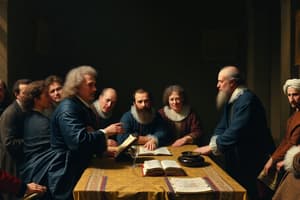Podcast
Questions and Answers
Shylock's pursuit of justice leads to the play's resolution.
Shylock's pursuit of justice leads to the play's resolution.
False (B)
The handkerchief in 'Merchant of Venice' symbolizes wealth and prosperity.
The handkerchief in 'Merchant of Venice' symbolizes wealth and prosperity.
False (B)
Portia disguises herself as a young servant in 'Merchant of Venice'.
Portia disguises herself as a young servant in 'Merchant of Venice'.
False (B)
The conflict between Shylock and Antonio in 'Merchant of Venice' is primarily legal in nature.
The conflict between Shylock and Antonio in 'Merchant of Venice' is primarily legal in nature.
The play 'Merchant of Venice' focuses on revenge as the central theme.
The play 'Merchant of Venice' focuses on revenge as the central theme.
Shylock's pursuit of justice in Merchant of Venice always stems from a desire for revenge.
Shylock's pursuit of justice in Merchant of Venice always stems from a desire for revenge.
Portia, in Merchant of Venice, is known for being a poor heiress with no intelligence or wit.
Portia, in Merchant of Venice, is known for being a poor heiress with no intelligence or wit.
Antonio's primary conflict in the play stems from his unrequited love for Portia.
Antonio's primary conflict in the play stems from his unrequited love for Portia.
Bassanio's pursuit of wealth in Merchant of Venice is primarily driven by his desire for power and control.
Bassanio's pursuit of wealth in Merchant of Venice is primarily driven by his desire for power and control.
Jessica's decision to elope with Lorenzo in Merchant of Venice leads to a significant conflict with her father Shylock.
Jessica's decision to elope with Lorenzo in Merchant of Venice leads to a significant conflict with her father Shylock.
Study Notes
Merchant of Venice: A Multi-layered Drama
Shakespeare's Merchant of Venice is a complex play that weaves together themes of love, justice, and revenge against a backdrop of Renaissance-era Venice. The following exploration will delve into its characters, themes, plot twists, symbolism, and conflicts, providing a rich understanding of this timeless masterpiece.
Characters
One of the most fascinating aspects of Merchant of Venice is the diverse range of characters it presents.
- Shylock - A Jewish moneylender, his unwavering pursuit of justice often conceals a deeper sense of vengeance.
- Portia - A wealthy heiress with intelligence and wit, her disguise as a young male lawyer leads to one of the play's most memorable courtroom scenes.
- Antonio - A merchant and Shylock's primary creditor, Antonio's love for his friend Bassanio and his willingness to pledge his life to secure a loan create the play's central conflict.
- Bassanio - A young and charismatic nobleman, Bassanio's love for Portia drives his pursuit of wealth.
- Jessica - Shylock's daughter, she elopes with Lorenzo, creating a secondary love story and resulting in Shylock's most significant conflict with her father.
Themes
Merchant of Venice explores several key themes, each intrinsically linked to the characters' stories.
- Justice - The play's central conflict revolves around the question of justice, from Shylock's pursuit of the law to Portia's legal manipulations, and the play's conclusion.
- Love - The play examines the complexity of love, from the romantic love between Portia and Bassanio to the familial love between Jessica and Lorenzo, and even the self-love of Shylock.
- Revenge - The play's subplot of Jessica's elopement with Lorenzo leads to Shylock's quest for revenge against his daughter, ultimately shaping the play's climax.
Plot Twists
Merchant of Venice contains several plot twists that keep the audience engaged and challenged.
- Portia's disguise - Portia disguises herself as a young lawyer, allowing her to outsmart the powerful men of Venice in court.
- The handkerchief - The handkerchief, a symbol of Portia's love, becomes central to the subplot involving Jessica and Lorenzo.
- Shylock's revenge - Shylock's desire for revenge against Antonio leads to the play's most notorious scene, in which he seeks to exact revenge through the cutting of a pound of Antonio's flesh.
- The "merciful" conclusion - Despite the play's focus on justice, the resolution is ultimately more merciful than expected.
Symbolism
Merchant of Venice is rich in symbolism, from the play's central item, a handkerchief, to its use of color and imagery.
- The handkerchief - Portia's handkerchief, a symbol of her love, plays a significant role in the play's events.
- Jewels - The play's emphasis on jewels, such as Portia's rings and Shylock's turquoise, adds to its overall themes of materialism and love.
- Clothing - The play's use of clothing, from Portia's disguise to the color schemes of characters, adds to its overall symbolism.
Conflicts
Merchant of Venice contains several conflicts, each driving the plot forward and testing its characters.
- Personal conflict - Shylock's struggle to maintain his identity in a world of Christian Venetians and his desire for revenge against Antonio create a central personal conflict within the play.
- Romantic conflict - The love between Portia and Bassanio, and Jessica and Lorenzo, create romantic conflicts that drive the play's subplots.
- Legal conflict - Shylock's pursuit of justice through the law creates a central legal conflict, leading to the play's climax.
In summary, Merchant of Venice is a complex and multi-layered play, rich in character, theme, plot twist, symbolism, and conflict. Its intricacies and depth continue to captivate audiences and scholars alike, making it a timeless masterpiece that remains relevant today.
Studying That Suits You
Use AI to generate personalized quizzes and flashcards to suit your learning preferences.
Description
Delve into the characters, themes, plot twists, symbolism, and conflicts within Shakespeare's complex play, Merchant of Venice. Explore the diverse range of characters, key themes like justice, love, and revenge, engaging plot twists, rich symbolism, and various conflicts that drive the narrative.




